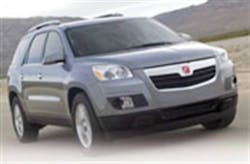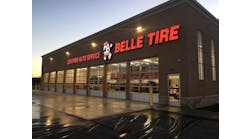High gas prices have forced a significant change in the North American vehicle sales mix over the last six months. Huge pickup trucks and SUVs are out and smaller, more fuel-efficient automobiles, like crossovers, are in.
With General Motors Corp., Ford Motor Co. and Chrysler LLC seeking billions of dollars in low-interest loans from the federal government to help them build more fuel-efficient vehicles while companies like Honda Motor Co. and Toyota Motor Corp. continue to push hybrid versions of their already fuel-efficient compacts, a return to the devil-may-care days when mammoth gas guzzlers like the GMC Yukon and Chevy Suburban ruled the road is unlikely.
However, even though many SUV owners are dumping their cumbersome vehicles, a good percentage of them are finding it hard to part with the comforts, amenities and utility that SUVs provided. That’s why crossovers -- more than 2.7 million of which were sold throughout the United States and Canada last year -- will continue to grow as a vehicle category, according to car manufacturers. (More than 3 million crossovers are expected to be sold by the end of 2008.) And that’s why you’ll continue to see more of them at your dealership.
[PAGEBREAK]
The next phase
“The crossover market tends to be about consumers who don’t want an SUV but don’t necessarily want a car,” says Melissa Montisano, general marketing manager for light truck and SUV tires, Goodyear Tire & Rubber Co., “and they’re at a stage where they certainly don’t need a minivan.”
Crossovers are “lifestyle” vehicles, according to tire manufacturers. “Crossovers meet the needs and fit the lifestyles of today’s consumers,” explains John Soule, Michelin brand light truck category manager, Michelin North America Inc. (MNA). “I think what makes them so popular is their versatility and the fact they have a lot of the features of a minivan, but have more styling.”
Crossover vehicles represent a “metamorphosis” from minivans and SUVs, says John Pecoraro, manager of product marketing, Cooper Tire & Rubber Co. “You have soccer moms who went through the minivan stage, then they went to SUVs and now they’re going to crossover vehicles. Crossovers are essentially passenger vehicles,” says Pecoraro, who’s fond of labeling them “modern-day station wagons.”
Due to high gas prices, “small cars are going to have a huge impact on the market, but I think on a long-term basis, crossovers are going to grow a lot faster,” says Mike Martini, president of original equipment, Bridgestone Firestone North American Tire (BFNT). “Crossovers are what the public wants. It’s amazing what crossovers have done versus pickups and SUVs.”
On the OE side
What tires are coming on crossover vehicles at OE? For starters, they’re P-metric, say Michelin’s Soule. P-metrics are better-suited for crossovers because crossover drivers “just don’t need the load carrying capacity for a crossover that they would for a full-size SUV.
“Some crossovers are all-wheel-drive and some ride higher than cars, but they’re built on a passenger car chassis,” says Pecoraro. “A lot of the running gear is the same and a lot of them ride on H- and V-rated tires, which puts them toward” the passenger vehicle category.
Most crossovers are coming from the factory equipped with 16- through 18-inch tire and wheel packages. “Popular sizes right now include 235/70R16, which is OE on the Ford Escape, and 235/65R17, which is OE on the Chrysler Pacifica and some others,” says Soule.
As for bigger tires, “there’s only one big size that I would say is mainstream right now, and that’s 255/60R19, which is OE on the Buick Enclave, a full-size vehicle.”
BFNT’s Martini doesn’t think sizes will extend beyond 18 inches “because of the physical dimensions available in (crossover vehicles’) wheel wells. But we are seeing a trend that’s been part of the SUV segment currently playing out in crossovers: increased diameters.”
He adds that his company also is starting to see “a movement toward tires that you would expect to see on a European sedan.”
[PAGEBREAK]
Replacement options
A number of tire manufacturers have been gearing up for the “crossover revolution” at the replacement level.
Last month, MNA introduced the Latitude Tour, which is “uniquely designed for crossover vehicles,” according to the company. The tire is available in 28 sizes. (Other products in MNA’s Latitude line include the Latitude Tour HP, which was introduced three years ago, and the Latitude Sport.)
Cooper has two tires for crossover applications, including the Cooper Discoverer CTS and the Cooper CS4 Touring.
Goodyear “offers a portfolio of brands that address crossover vehicles,” says Montisano. Other tire manufacturers like BFNT are addressing the segment as well.
Crossover vehicles “tend to be focused a bit more on lower speed ratings -- predominantly T or S” than traditional SUV tires, says Montisano. “In addition to that, it’s not so much about the tire’s internal construction that’s different, but (the differences are) more aesthetic.
“We’re also starting to see more of a touring tread emerge. It’s less about the ruggedness of the pattern and more about (the tread pattern’s) on-highway appearance. We’re not seeing a lot of blockiness.”
Look for the label?
Will there ever be an industry-wide crossover tire designation, similar to how certain P-metric and light truck tires are commonly referred to as SUV tires? The tiremakers MTD spoke with are split in their opinions.
Goodyear’s Montisano says the crossover segment “is more of a sub-set of what we already have. I don’t think we’ll get to a position to where we are specifically calling out ‘crossover tires.’”
Cooper doesn’t recognize a specific crossover category, says Pecoraro. “With all the size proliferation, our dealers tend to like a ‘go to’ powerline where you can have one line with all kinds of different sizes. For the sake of simplicity, it’s easier to put it all into one product.
“In terms of design, crossover owners want a smooth ride, good mileage, good traction -- they have the same needs as a standard passenger sedan owner.”
Michelin’s Soule concurs -- to a point. “Crossover vehicles are unique in that they’re able to do a lot of different things. They provide a comfortable ride, they have a higher center of gravity than a sedan and they’re able to go off-road.
"All of this means you need everything from good dry grip and excellent wet traction to truck tire-like toughness and durability.”
Soule says several years ago, before the launch of the Latitude Tour HP, MNA officials were working with representatives from the company’s advertising agency to come up with a marketing plan for the tire “and people were debating whether or not to include the word ‘crossover’ in our ad copy.
“At the time, most people didn’t know what a crossover was. Now they’ve become part of the vernacular. We think the market is ready for crossover tires.”



